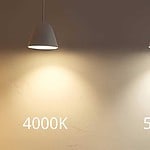Lighting is a critical aspect of the home or office environment. It is not about the utility but the effect it has on the space’s aesthetics and the mood it produces. Selecting the wrong lighting hinders daily chores and can also decrease productivity. Hence, while choosing a light, it is vital to consider several factors. These include color temperature, luminosity, and energy consumption.
The lighting in homes and offices ranges between 2700K and 4000K. Unfortunately, the latter can be too bright for most spaces, limiting its applications. Thus, the choice comes down to either 2700K or 3000K. And if you have clicked on this blog, chances are you cannot figure out which one is the best for you. But there is no need to worry as we have covered you with this blog. So, let’s find out which of the 2700K and 3000K would work for you.
What Exactly is Color Temperature?

We must understand the color temperatures to select the appropriate lighting for the household. Kelvin or K is a scale to describe color temperature, which ranges between 1,000 to 10,000. So, lights with different color temperatures have varying characteristics. These include ambience, luminosity, and appearance.
At ranges between 2000 K to 3000K, the lights produce an orange-to-yellow-white appearance, also known as “warm white.” “Neutral White” are the lights between 3100 to 4500 on the Kelvin scale. These lights produce neutral white light with a slight blue tint.
Color temperatures of more than 4500K produce “daylight,” a blue-white appearance. Lights above 6500K are reserved for special applications and are beyond the scope of our discussion.
2700K vs. 3000K – What Are The Differences?
Although there is not much difference on the Kelvin scale between both lights, they have different appearances. And it varies their application as well. The 3000K lights produce a softer-white glow. 2700K, on the other hand, is on the yellowish side of the spectrum. The 2700K has warmer light, which resembles traditional incandescent bulbs more closely. These color temperatures are somewhat like conventional bulbs. Their applications include living rooms, kitchens, bedrooms, and bathrooms.
You can also use both lights in the same space. For example, the 2700K LED strips can be used as ambient lights. You can install 300K LED bulbs under the cabinet to brighten the countertop. It would create the perfect blend of both temperatures. So, it would enhance utility and aesthetics.
That said, the differences between the two light colors are noticeable only if these are used in a single home. For example, you will not notice a difference if you spend a night in a room with 2700K lights and next with 3000K. But, if both lights are installed in spaces immediately next to each other, there are some noticeable differences.
| Attribute | 2700K (Warm White) | 3000K (Soft White) |
|---|---|---|
| Appearance | Yellowish-white, like incandescent bulbs | Slightly whiter, with a warmer hue |
| Atmosphere | Cozy, inviting, and warm | Soft, warm, yet a bit more neutral |
| Ideal Environments | Bedrooms, living areas, dining rooms | Bedrooms, living areas, dining rooms, kitchens |
| Color Rendering Index (CRI) | Good color rendering, typically 80-90 | Good color rendering, typically 80-90 |
| Blue Light Emission | Lower blue light emission | Slightly higher blue light emission |
Blue Light Hazard – How Do 2700K and 3000K Compare?

Blue light hazard is one of the most talked about topics, and rightfully so. It is because of the danger it poses to health. Smartphones, laptops, computers, and tablets produce blue light. And it is harmful to our health. It suppresses the production of the sleep-regulating hormone melatonin. Thus, it disturbs sleep when one is exposed to it before bedtime.
And the emission of blue light is not limited to smartphones and tablets. Any light source can produce this hazard. Thus, it creates genuine concerns in some people while selecting LED lights. But, the higher the Kelvin temperature, the more blue light is emitted. Therefore, the 3000K lights emit more blue light than the 2700K counterparts.
But does that mean you should not use 3000K altogether? It certainly does not. First, although there is a difference between the blue light emission of both lights, it is not significant. Most smartphones and tablets are calibrated to 6500K, which produces a daylight-like appearance. Hence, their impact on our sleep cycle is substantial.
2700K and 3000K lie on the whiter side of the spectrum. The blue light emission from either of these temperatures is not too high. They would not disturb our sleep cycles. Furthermore, there is more to blue light emission than color temperature. Other factors such as luminosity, distance from the light source, and duration of exposure also play essential roles.
For example, a 2700K light with higher lumens would negatively affect more than 3000K with lower lumens. Similarly, a 2700K light installed closer to the bed, couch, or any other seating space would impact more than a 3000K light installed at a distance.
The bottom line is the emission of blue light should not be considered while selecting either of these color temperatures.
How can the Color Rendering Index Help In the Selection of Lights?
While both of these lights would work in all of the mentioned spaces, it is ideal for analyzing several factors to select the ideal one. And the best way to do so is to use Color Rendering Index. It tells how a combination will look under a light source compared to its appearance under sunlight. Ideally, artificial light should mimic the sunlight in a particular environment and highlight all objects’ colors.
The maximum CRI or Color Rendering Index score is 100, and anything above 90+ would make a decent choice. Most reputed brands write the CRI number of their product. It makes selecting appropriate light easier. However, the 90+ score is not necessarily a rule. And the lights with lower CRI scores can be used where you prefer a darker environment. For example, it could be the bedrooms and living rooms for relaxing.
Furthermore, even within the 2700K and 3000K light colors, there are variations in the CRI score. Hence, it is crucial to look for it while making the purchase. Another factor that can influence light’s appearance is luminosity expressed in lumens. The higher the lumens, the brighter the light. Ideally, the 2700K should offer 725 lumens, whereas the 3000K should be as bright as 800 lumens. Anything above or below would alter the appearance of light.
2700K vs. 3000K – The Better Option For Different Spaces in a House
Different spaces in the house have different aesthetics. Hence, they have varying requirements when it comes to lighting. So let’s see which 2700K and 3000K lights suit better in these other areas.
For Bathrooms
The bathrooms should appear clean, fresh, and bright. To achieve that, it requires a light that produces a whitish color. On the other hand, the 2700K would not look too good in the bathrooms. It is because of its slightly yellowish shades. Thus, light temperatures between 3000K to 4000K would be an excellent choice.
There will be a significant difference between 2700K and 3000K lights if the bathroom has light-coloured walls. 2700K takes away the original color and imparts a yellowish tone. On the other hand, 3000K lights would not just maintain the actual color but also provide a more pleasant look.
For Kitchen
Selecting an appropriate color temperature for the kitchen is probably the most complicated. There are a lot of factors that need to be accounted for before opting for a light color. 3000K can be great for a kitchen with traditional, darker wooden cabinetry. It highlights grains and also enhances the earthy tones. On the other hand, warmer colors like 2700K can take away the shine from the wood and make it look dull and pink. Some even suggest going as high as 4000K for Kitchen with traditional designs.
On the other hand, the 2700K lights would look better in a contemporary-style kitchen. Choosing a 3000K or higher temperature for such a kitchen would make it look pink.
For more detail information, you can read How To Choose the LED Strip Lights For Kitchen Cabinets?
For Living Rooms
The interiors of the living rooms vary significantly in different houses. And factors like wall color, decor, and the intensity of natural light play significant roles in selecting the appropriate color temperature. Both color temperatures work well in these spaces, especially if the area has an earthy tone. You would find them even more appealing if the living room is styled traditionally.
However, for living rooms with modern aesthetics, it is best to opt for cooler temperatures that range between 3500K to 4800K. Another important factor while selecting the light for the living room is the mood it produces. Living rooms are not used only to relax. Sometimes, you must conduct certain chores in these spaces. So, going with just 2700K light might make you feel drowsy all the time and would not make the ideal choice. But when it comes to relaxation, 2700K is more suited.
Hence, installing a combination of both lights at different places is better. You can switch them on according to the mood you want to set.
For Bedrooms
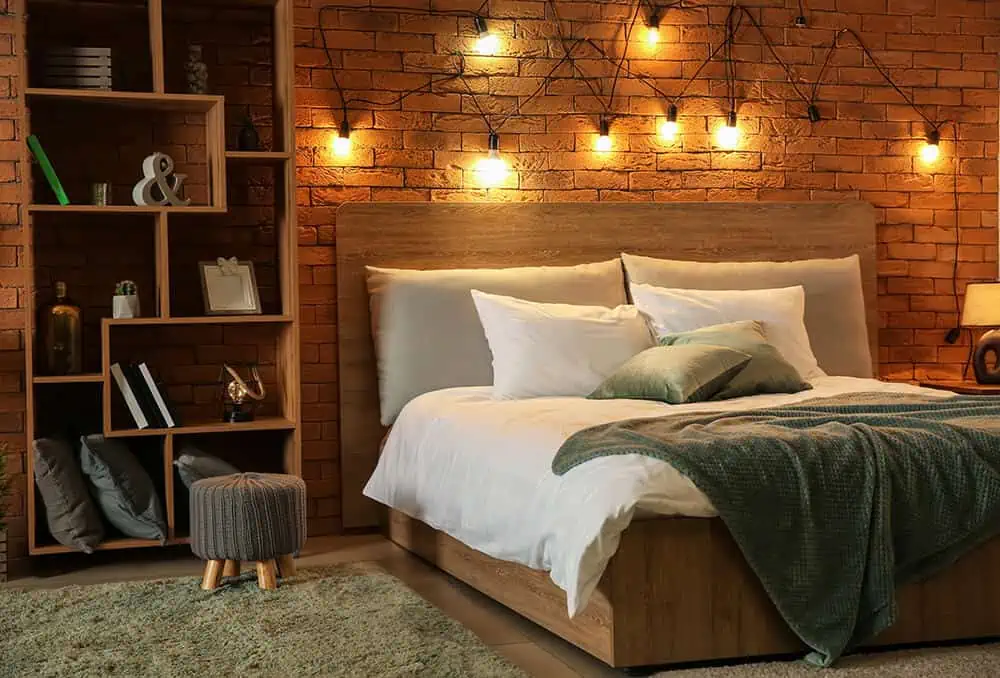
The bedroom should have a cozy and inviting atmosphere. You can achieve this by installing warmer lights. Since the 2700K lights lean more towards warmth, they make better choices for these spaces. In addition, the 2700K lights would trigger melatonin production. Hence, they make you feel drowsy and sleepy. Such an environment would help improve the quality and duration of sleep.
That said, some people also have workstations in their bedrooms. And with 2700K lights, you would do little work. You would always feel tired and sleepy, which would decrease productivity. These people should install at least one LED with a temperature of 3000K in the bedrooms. You can switch it on while working and turn it off just before sleep.
2700K vs. 4000K – A Comprehensive Comparison
When comparing 2700K and 4000K lighting options, it’s essential to understand the significant differences in their characteristics and applications. While 2700K falls under the “warm white” category, 4000K is considered “cool white.” Let’s dive deeper into their distinctions and find out which one might be more suitable for different spaces in a house.
| Feature | 2700K (Warm White) | 4000K (Cool White) |
|---|---|---|
| Appearance | Yellowish-white, similar to incandescent | Whiter light with a subtle blue tint |
| Ambience | Warm, cozy, and inviting | Clean, bright, and modern |
| Ideal Spaces | Bedrooms, living rooms, dining rooms | Kitchens, bathrooms, offices, retail spaces |
| Color Rendering Index (CRI) | Good color rendering, typically 80-90 | Better color rendering, typically 90+ |
| Blue Light Emission | Lower blue light emission | Slightly higher blue light emission |
In terms of appearance, 2700K lights emit a yellowish-white glow reminiscent of traditional incandescent bulbs, creating a warm, cozy, and inviting atmosphere. These lights are best suited for bedrooms, living rooms, and dining rooms, where relaxation and comfort are prioritized. On the other hand, 4000K lights emit a whiter light with a subtle blue tint, which gives spaces a cleaner, brighter, and more modern appearance. They are ideal for kitchens, bathrooms, offices, and retail spaces that require higher visibility and a more energizing environment.
When it comes to color rendering, 4000K lights generally have a higher CRI, indicating better color accuracy compared to 2700K lights. However, both options have decent color rendering capabilities, making them suitable for various applications.
Lastly, the blue light emission from 4000K lights is slightly higher than that of 2700K lights. Although the difference is not significant, it is essential to consider the potential impact of blue light exposure on sleep and overall well-being when selecting lighting options for your home or office.
In conclusion, the choice between 2700K and 4000K lighting depends on the specific requirements of the space, the desired ambience, and personal preferences. By understanding the key differences between these two color temperatures, you can make a more informed decision when selecting the best lighting for your needs.
Smart lights – The Most Effective Solution?
Smart lights are a relatively new invention you can control via a smartphone. You can adjust brightness and color temperature with a click on the smartphone. These are the best solutions for places where one color temperature does not work. You can install them and switch the color temperature based on the mood you want to set.
For example, while working in a living room, you can set the temperature of these lights to 4000K. And when the work is done, you can tone it down to 2700K to relax.
However, the major shortcoming of these lights is their price. It is significantly higher than typical LED strips. You can purchase multiple LEDs for the cost of one smart light. Hence, it would help if you only used these lights in spaces where you are unsure which light would work the best. Use the typical LED lights in other areas to cut down expenses.
FAQs
2700K lights are suitable for spaces where you want to create a warmer appearance. These should also be installed in areas where you have to relax, such as bedrooms and living rooms.
3000K is not too bright and is one of the preferred bedroom choices. This temperature creates a cozy and inviting atmosphere which is great for relaxing.
2700K light would work for bedtime reading because it is enough to make the text readable while producing a relaxing feel simultaneously. However, it would not work well if you want to read something with great focus.
3000K lights are on the warmer scale of the spectrum, which offers a similar appearance to traditional incandescent lights. But these lights are not as yellow as the 2700K counterparts.
Color temperature can have a significant impact on the mood and atmosphere of a room. Warmer color temperatures, such as 2700K, create a cozy and inviting ambiance, while cooler color temperatures, such as 3000K, provide a slightly more neutral and versatile atmosphere.
The energy efficiency of a light depends primarily on the type of lighting technology used (e.g., LED, CFL, incandescent) rather than the color temperature. Both 2700K and 3000K lights can be equally energy efficient if they use the same lighting technology.
Although 3000K lights have a slightly higher blue light emission than 2700K lights, the difference is minimal. However, it is still essential to consider the potential impact of blue light exposure on sleep and overall well-being when selecting lighting options for a bedroom.
While it’s possible to mix different color temperature lights in a single room, it is generally recommended to stick with one consistent color temperature throughout the space. This creates a more cohesive and harmonious atmosphere.
To determine the best color temperature for your space, consider the intended function and desired ambiance of the room. For areas that require a cozy and warm atmosphere, such as living rooms or bedrooms, 2700K lights would be suitable. For spaces where a more neutral and versatile light is desired, such as kitchens or home offices, 3000K lights might be a better option.
Conclusion
On the surface, there is not much difference between the 2700K and 3000K lights because of their closeness on the Kelvin scale. However, both lights have slightly different characteristics, which impact their applications. For example, 2700K lights are warmer, and 3000K are whitish. Hence, you would have to take the different factors like interior, furniture, and the paints of the wall into account to select the best one.
However, in most cases, it all comes down to personal preferences. For example, some people may like the appearance of 2700K, while others might prefer 3000K. Nonetheless, knowing what you are getting into before purchasing is essential. And we hope this piece has made that clear.
We are a factory specializing in producing high-quality customized LED strips and LED neon lights.
Please contact us if you need to purchase LED lights.


